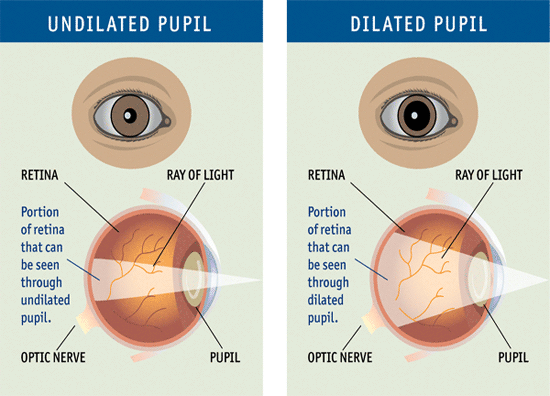
Comprehensive eye exam
You may think your eyes are healthy, but visiting an eye care professional for a comprehensive dilated eye exam is the only way to really be sure. During the exam, each eye is closely inspected for signs of common vision problems and eye diseases, many of which have no early warning signs. Annual comprehensive dilated eye exams are generally recommended starting at age 60. However, African Americans are advised to start having comprehensive dilated eye exams starting at age 40 because of their higher risk of glaucoma. It’s also especially important for people with diabetes to have a comprehensive dilated exam at least once a year.
Key elements of a comprehensive dilated eye examination include dilation, tonometry, Visual field test and a visual acuity test.
Dilation is an important part of a comprehensive eye exam because it enables your eye care professional to view the inside of the eye. Drops placed in each eye widen the pupil, which is the opening in the center of the iris (the colored part of the eye). Dilating the pupil allows more light to enter the eye the same way opening a door allows light into a dark room. Once dilated, each eye is examined using a special magnifying lens that provides a clear view of important tissues at the back of the eye, including the retina, the macula, and the optic nerve
In a person with diabetic retinopathy, the most common diabetic eye disease and a leading cause of blindness in the United States, the exam may show swelling or leaking of blood vessels in the retina, the light-sensitive layers of tissue at the back of the eye. The eye care professional may also see abnormal growth of blood vessels in the retina associated with diabetic retinopathy.
In age-related macular degeneration (AMD), a common cause of vision loss and blindness in people over the age of 50, the exam may show yellow deposits called drusen or clumps of pigment beneath the retina. In some cases, the exam may also show abnormal growth of blood vessels beneath the retina. These AMD-related changes tend to cause deterioration of a small area of the retina called the macula, which is needed for sharp, central vision.
A comprehensive dilated eye exam is also critical for detecting glaucoma, a disease that damages the optic nerve, which carries information from the eyes to the brain. In a person with glaucoma, the dilated exam may show changes in the shape and color of the optic nerve fibers. The exam may also show excessive cupping of the optic disc, the place where the optic nerve fibers exit the eye and enter the brain.
Tonometry is a test that helps detect glaucoma. By directing a quick puff of air onto the eye, or gently applying a pressure-sensitive tip near or against the eye, your eye care professional can detect elevated eye pressure, which can be a risk factor for glaucoma. Numbing drops may be applied to your eye for this test.
A Visual field test measures your side (peripheral) vision. A loss of peripheral vision may be a sign of glaucoma.
A Visual acuity test will require you to read an eye chart, which allows your eye care professional to gauge how well you see at various distances